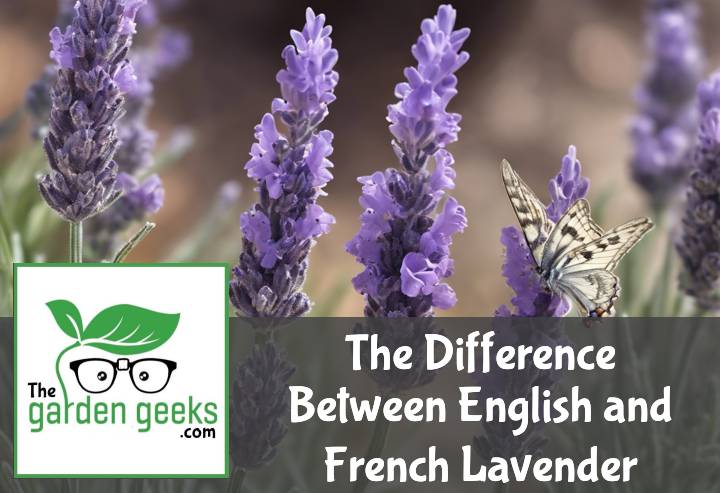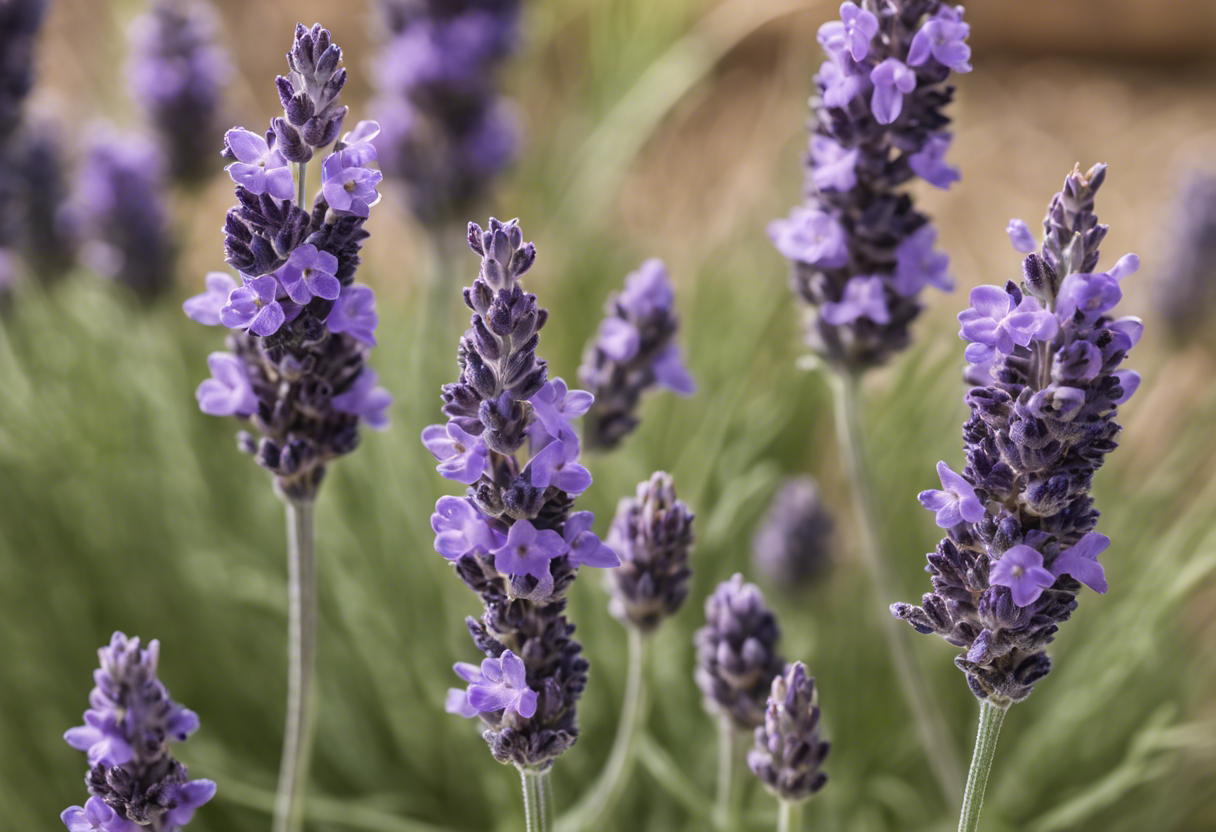Ever wandered through a garden, absolutely entranced by the sweet scent of lavender wafting through the air? I have, and let me tell you, it’s nothing short of magical. But did you know that not all lavenders are created equal? Specifically, there’s a world of Difference Between English and French Lavender out there waiting to be explored!
So buckle up, plant enthusiasts! We’re about to embark on an aromatic journey that’ll leave us with a newfound appreciation for these fragrant beauties. Keep reading about The Difference Between English and French Lavender.
Key Takeaways
- English and French Lavender are different species with distinct characteristics.
- English Lavender (Lavandula angustifolia) is hardier, has a sweet scent, and is used in cooking and essential oils.
- French Lavender (Lavandula stoechas) prefers warmer climates, has a strong camphor-like smell, and is primarily ornamental.
- The two types also differ in appearance: English lavender has long stems with flowers at the top, while French lavender has shorter stems with flower clusters.
What is Lavender?
Ah, lavender! This fragrant beauty is more than just a pretty plant. Originating from the Mediterranean, lavender has been charming humans for centuries with its sweet scent and lovely purple blooms. Now, let’s talk about the two main types – English Lavender and French Lavender.
Definition and Brief History of Lavender
So, what exactly is lavender? Well, it’s a type of flowering plant in the mint family. The name “lavender” comes from the Latin word “lavare,” which means “to wash.” Back in Roman times, people used it to scent their baths, beds, clothes… you name it!
But lavender isn’t just ancient history. Over time, folks started cultivating this versatile plant all over the globe. From Europe to Africa to Asia – everyone wanted a piece of this aromatic action.
Importance and Uses of Lavender
Nowadays, lavender is still quite the popular kid on the block. Its importance can’t be overstated. It’s like that multi-talented friend we all have – good at everything!
In cosmetics, lavender oil is a superstar ingredient. It’s known for its soothing properties and heavenly smell. But wait – there’s more! In culinary arts, chefs use it to add a unique flavor twist to dishes. Ever tried lavender-infused ice cream or honey? If not, you’re missing out!
And let’s not forget about aromatherapy. A few drops of lavender oil in your diffuser can turn your home into a relaxing sanctuary. Talk about versatility! That’s our dear friend lavender for you – always surprising us with its many talents.
Remember folks; knowing the difference between English and French Lavender can help you pick the right one for your needs!
Understanding English Lavender
When it comes to the difference between English and French lavender, it’s crucial to understand what makes English Lavender unique. Known for its rich aroma and vibrant colors, this plant is a favorite among gardeners worldwide.
Characteristics of English Lavender
English Lavender boasts a distinct lavender scent profile that’s both soothing and invigorating. Its flowers range from pale pink to deep purple, adding a splash of color to any garden. The size of English Lavender varies, but most plants reach about 1 to 2 feet in height.
The leaves are silvery-green, providing a beautiful contrast against the colorful blooms. The overall texture of English Lavender is quite soft, making it an excellent choice for sensory gardens.
Growing Conditions for English Lavender
If you’re considering growing lavender in your garden, there are a few key things to keep in mind. First off, these plants love sunlight – they need at least six hours of direct sun each day.
Next up is soil. English Lavender prefers well-drained soil with neutral to slightly alkaline pH levels. Overwatering can lead to root rot, so be sure not to water too frequently.
Lastly, the climate plays a significant role in the successful growth of these plants. They thrive best in temperate climates and struggle in areas with high humidity or extreme cold.
Common Varieties of English Lavender
There are several popular types of English Lavender that you might come across. The Munstead lavender variety is known for its compact size and early bloom time, making it perfect for small gardens or containers.
The Hidcote blue variety stands out with its dark purple flowers and strong fragrance – an excellent choice if you’re looking to make homemade potpourri or essential oils.
Finally, the Royal Purple variety lives up to its name with stunning, royal purple blooms that are sure to turn heads. Each of these varieties brings something unique to the table, so choose based on your personal preferences and garden conditions.
Understanding French Lavender
French Lavender, with its unique features and charm, is a gardener’s delight. It’s not just about the vibrant purple flowers; there’s more to this plant than meets the eye. Let’s delve into the world of French Lavender care, exploring its characteristics, ideal growing conditions, and common varieties.
Characteristics of French Lavender
The French Lavender plant is a sight to behold. Its grey-green leaves are narrow and serrated, giving it a distinct look. The color? A stunning purple that can make any garden pop!
But wait until you get a whiff of it! The scent of French Lavender is slightly sweet yet robust, with hints of rosemary and pine. It’s like having your own natural perfume factory in your backyard.
Growing Conditions for French Lavender
Growing French Lavender isn’t rocket science; it just needs some love and the right conditions. First off, the soil – well-drained soil is key here folks! Your lavender will thank you for it.
Next up – sunlight. These plants are sun worshippers! They need full sunlight exposure to truly thrive. So find that sunny spot in your garden for them.
And let’s not forget about watering. Less is more when it comes to watering French lavender. Overwatering can lead to root rot – definitely something we want to avoid!
Common Varieties of French Lavender
There are several popular types of French lavender, each with their own unique appeal. ‘Fathead’ is known for its large flower heads (hence the name), while ‘Hidcote Giant’ stands tall with its height reaching up to 90cm!
Then there’s ‘Grosso’, loved for its strong fragrance and high oil content – perfect if you’re into making your own essential oils at home.
Remember folks, the Difference Between English and French Lavender is more than just geography. It’s about characteristics, growing conditions, and varieties too!
Key Differences Between English and French Lavender
When it comes to the difference between English and French lavender, there’s more than meets the eye. Sure, they both belong to the lavender family, but their characteristics vary quite a bit.
Differences in Appearance
The first thing you’ll notice is their looks. English Lavender tends to be a tad more conservative with its muted purple flowers and compact size. It’s like the quiet, well-behaved child of the lavender varieties.
On the other hand, French Lavender is all about making a statement. Its vibrant violet blooms are larger and its overall shape is more sprawling. It’s definitely not shy about showing off its beauty!
Differences in Growth and Cultivation
Now let’s talk about growth habits and cultivation requirements. Growing English Lavender can be a bit tricky as it prefers cooler climates and well-drained soil.
On the flip side, Cultivating French Lavender is like dealing with a laid-back surfer dude. It thrives in warmer conditions and isn’t too fussy about soil type. Just give it plenty of sunshine, man!
Differences in Scent and Oil Composition
Finally, we come to scent and oil composition – where things get really interesting! The scent of English vs French Lavender is quite distinct.
The English variety has a sweet, floral aroma that makes you feel like you’re prancing around an old English garden (cue Pride & Prejudice). Meanwhile, French lavender has a stronger, slightly camphorous scent that’s reminiscent of a breezy Mediterranean afternoon.
As for their oil compositions? Well, they’re as different as chalk and cheese! But that’s another story for another day…
Practical Implications of the Differences
Alright, let’s get down to brass tacks. The difference between English and French Lavender isn’t just about looks or where they grow best. Nope, it’s also about how you can use them practically. We’re talking gardening and aromatherapy here.
Choosing Between English and French Lavender for Gardening
So, you’ve got a green thumb and you’re thinking about adding some lavender to your garden? Good on ya! But which one should you choose: English or French lavender? Well, it depends on what you want from your garden.
If you’re after a hardy plant that can withstand cold winters, then English lavender in the garden is your best bet. It’s like the tough guy of lavenders – doesn’t mind a bit of frost and can even handle a bit of neglect (not that we’re suggesting you neglect your plants!).
On the flip side, if you live somewhere with mild winters and hot summers, then French lavender in the garden might be more up your alley. It loves basking in the sun like a cat on a windowsill. Plus, its bloom period lasts longer than English lavender – talk about showing off!
Choosing Between English and French Lavender for Aromatherapy
Now let’s talk smells – because who doesn’t love a good whiff of lavender? When it comes to aromatherapy, both types have their perks.
The scent of English vs French lavender aroma is quite different. English lavender has a sweet floral scent with minty notes – think summer meadows meets candy store. It’s perfect for relaxation and promoting sleep.
French lavender, however, has a strong camphor-like smell with hints of rosemary. It’s less sweet but more potent – great for clearing your sinuses or giving you that wake-up call in the morning!
So, when choosing lavender for aromatherapy, think about what you want from it. Need a good night’s sleep? Go English. Want to feel invigorated and alert? French is your friend. Either way, you’re in for a treat!
To Wrap Up
Just like choosing between a chocolate eclair and a croissant, understanding the Difference Between English and French Lavender can be quite a treat! Both have their unique charm, aroma, and uses.
So whether you’re after the sweet scent of English lavender for your calming tea or the robust fragrance of French lavender to jazz up your garden, remember – variety is the spice of life!





